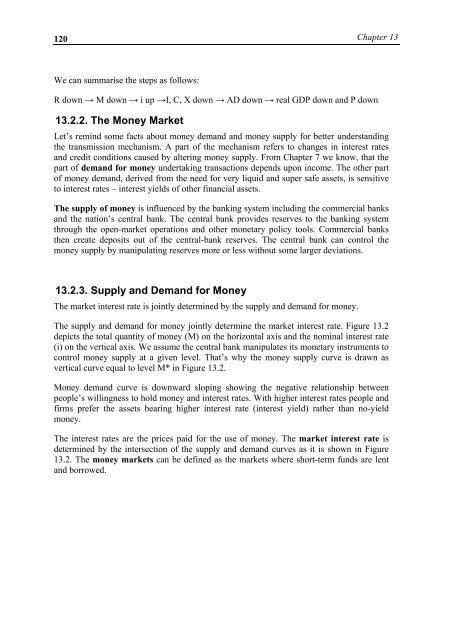MacroeconomicsI_working_version (1)
Create successful ePaper yourself
Turn your PDF publications into a flip-book with our unique Google optimized e-Paper software.
120<br />
Chapter 13<br />
We can summarise the steps as follows:<br />
R down → M down → i up →I, C, X down → AD down → real GDP down and P down<br />
13.2.2. The Money Market<br />
Let’s remind some facts about money demand and money supply for better understanding<br />
the transmission mechanism. A part of the mechanism refers to changes in interest rates<br />
and credit conditions caused by altering money supply. From Chapter 7 we know, that the<br />
part of demand for money undertaking transactions depends upon income. The other part<br />
of money demand, derived from the need for very liquid and super safe assets, is sensitive<br />
to interest rates – interest yields of other financial assets.<br />
The supply of money is influenced by the banking system including the commercial banks<br />
and the nation’s central bank. The central bank provides reserves to the banking system<br />
through the open-market operations and other monetary policy tools. Commercial banks<br />
then create deposits out of the central-bank reserves. The central bank can control the<br />
money supply by manipulating reserves more or less without some larger deviations.<br />
13.2.3. Supply and Demand for Money<br />
The market interest rate is jointly determined by the supply and demand for money.<br />
The supply and demand for money jointly determine the market interest rate. Figure 13.2<br />
depicts the total quantity of money (M) on the horizontal axis and the nominal interest rate<br />
(i) on the vertical axis. We assume the central bank manipulates its monetary instruments to<br />
control money supply at a given level. That’s why the money supply curve is drawn as<br />
vertical curve equal to level M* in Figure 13.2.<br />
Money demand curve is downward sloping showing the negative relationship between<br />
people’s willingness to hold money and interest rates. With higher interest rates people and<br />
firms prefer the assets bearing higher interest rate (interest yield) rather than no-yield<br />
money.<br />
The interest rates are the prices paid for the use of money. The market interest rate is<br />
determined by the intersection of the supply and demand curves as it is shown in Figure<br />
13.2. The money markets can be defined as the markets where short-term funds are lent<br />
and borrowed.




